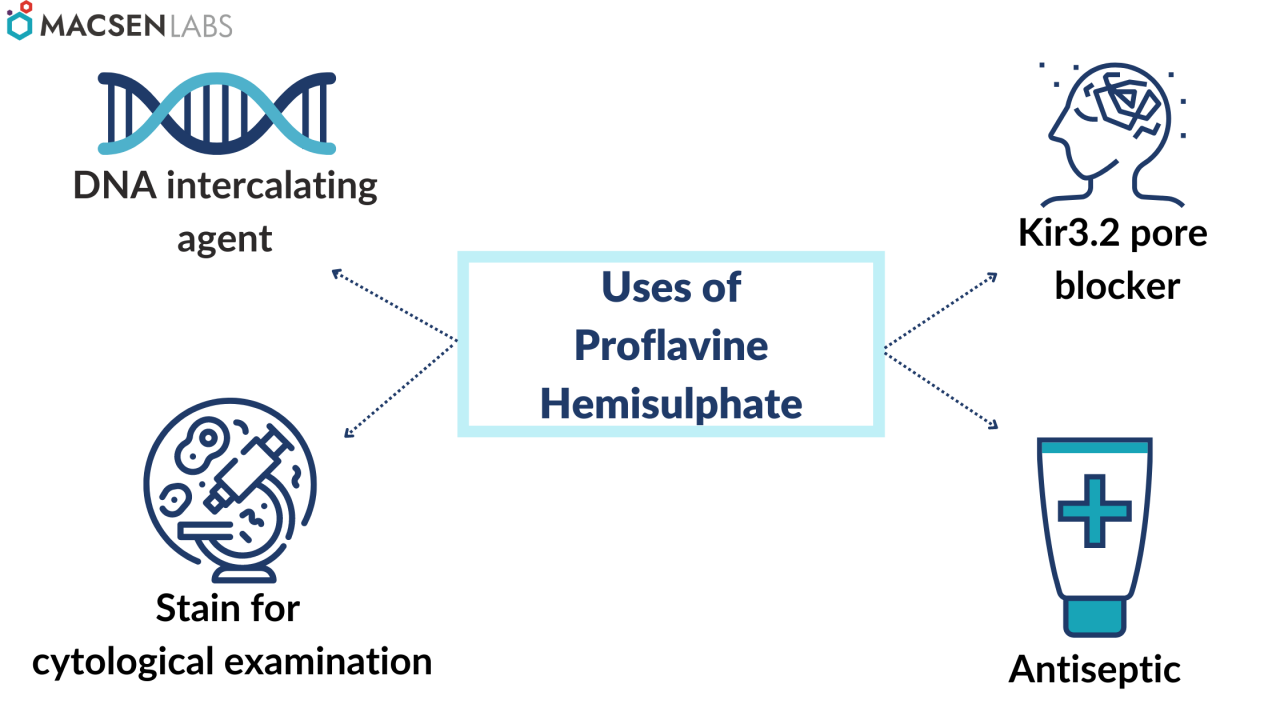Table of Contents
What is Proflavine Hemisulphate
Proflavine Hemisulphate, also known as proflavin or diaminoacridine, is an acriflavine derivative that works as a disinfectant and bacteriostat against gram-positive bacteria. It was previously used as a urinary antiseptic and has been used as a topical antiseptic in the form of dihydrochloride and hemisulfate salts for treating superficial wounds.
Proflavine Hemisulphate API solution is used as a fluorescence contrast agent used in high-resolution optical imaging devices like the high-resolution microendoscope to visualize cell nuclei. These devices use real-time imaging to differentiate between normal and cancerous tissue. These images may be useful for the early detection of oral cancer and its precursors, as well as for determining precise malignant tissue margins for ablative surgery. To improve compounding efficiency in the pharmacy, extemporaneous preparation of proflavine solution for these diagnostic procedures requires batch preparation and long-term storage. Long-term stability data for proflavine contrast solutions, on the other hand, is scarce.
Proflavine is also known to cause DNA mutations by intercalating between nucleotide base pairs. It differs from the majority of other mutagenic components in that it causes basepair deletions or insertions rather than substitutions. Proflavine can cause double-stranded breaks in DNA when exposed to light.
Chemical Structure & properties

- It is a hemisulphate salt of acridine derivative-proflavine, with a chemical formula of C26H24N6O4S, and a molecular weight of 516.6 daltons.
- IUPAC Name: acridin-10-ium-3,6-diamine;sulfate
- It is also known as 3,6 Diaminoacridine, Acridine, 3,6-Diamino, and Proflavin.
- The solubility of Proflavine Hemisulphate in water is 10mg/ml.
- Proflavine absorbs strongly in the blue region at 445 nm (in water at pH 7).
- It can be stored at room temperature.
- Proflavine disrupts DNA synthesis and causes high levels of mutation in the copied DNA strands by intercalating DNA (intercalation). This stops bacteria from reproducing, thereby exhibiting an antibacterial effect.
- It is also used as a rapid stain for cytological studies of biological specimens as it stains cytoplasmic structures and nuclei.
Patents of Proflavine Hemisulphate
| Patent Number | Patent Name | Date of Patent |
|---|---|---|
| CN-112336864-A | Application of proflavine in lung cancer treatment | 2019-08-08 |
| WO-2021023291-A1 | Use of proflavine in treatment of lung cancers | 2019-08-08 |
| US-2020405544-A1 | Wound Closure Systems for Reducing Surgical Site Infections Comprising Incision Drapes Filled with Releasable Antimicrobial Agents | 2019-06-28 |
| US-2020325543-A1 | Diagnostic method | 2017-11-20 |
Refer here for more details.
Clinical Trials
| Phase | Status | Purpose | Conditions |
|---|---|---|---|
| 2 | Recruiting | Other | Esophagus, Barrett |
| 2 | Recruiting | Other | Prior History of Squamous Cell Dysplasia and /or Neoplasia / Suspected or Known Squamous Cell Neoplasia |
| 2 | Withdrawn | Treatment | Uterine Malignancies |
| 1 | Terminated | Diagnostic | Malignant Neoplasm of Stomach |
| 0 | Active Not Recruiting | Prevention | Malignant Neoplasms of Female Genital Organs |
| 0 | Completed | Diagnostic | Cervical Cancer |
| 0 | Completed | Screening | Cell Cancer, Squamous |
Refer here for more details.
Uses of Proflavine Hemisulphate

- Acridine dye Proflavine Hemisulfate is a well-known DNA intercalating agent, thus acting as an antimicrobial agent that kills bacteria.
- Proflavine hemisulfate acts as a Kir3.2 pore blocker. Proflavine hemisulfate has the potential to be a lead compound in the treatment of Kir3.2-related neurological diseases. Proflavine inhibits Kir3.2-transformant cell growth and Kir3.2 activity in a concentration-dependent manner (0.1-10 M; 24 hours).
- Proflavin possess antiseptic property and is therefore used in wound dressings to prevent infections.
- Acridine-derived fluorescent dye proflavine hemisulfate can be used as a rapid stain for cytologic examination of biological specimens. Because of its small amphipathic structure and ability to intercalate DNA, proflavine fluorescently stains cell nuclei and cytoplasmic structures. Proflavine staining could enable quantitative morphologic comparisons between many different cell types while simplifying current imaging lab procedures.
Side effects
Proflavine has been found to possess carcinogenic properties, due to its mutation causing nature. There are no side effects reported from this compound yet.
FAQs
Q. Where is Proflavine found?
Proflavine is only found in people who have used or taken this medication.
Q. What is the storage condition of Proflavine?
Chemical stability was maintained in solutions stored at room temperature for up to six months (94-105%). Conclusion: Under refrigeration, proflavine solutions at 0.01% concentration were chemically and physically stable for at least 12 months. When stored at room temperature, the solution remained chemically stable for six months.
Q. Is Proflavine a mutagen?
Proflavin is known to have a mutagenic effect on DNA and causes basepair-deletions/basepair-insertions rather than substitutions. It can also induce double-stranded breaks in DNA in the presence of light.
Disclaimer-
The information provided here is based on general knowledge, articles, research publications etc and we do not claim the authenticity of any of the information provided above. We do not claim or suggest/advise any medical, therapeutic, health or nutritional benefits of Proflavine Hemisulphate. We do not supply or promote our Proflavine Hemisulphate product for the applications which are covered by valid patents and which are not approved by the FDA.
Macsen Labs is a manufacturer and supplier of several grades of Proflavine Hemisulphate such as:-


